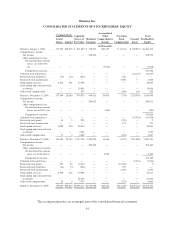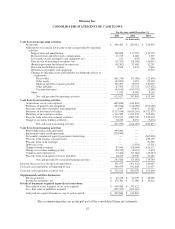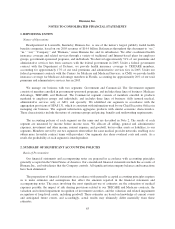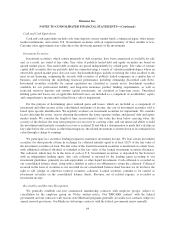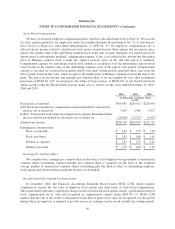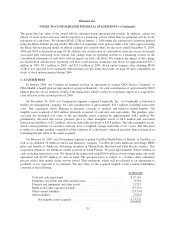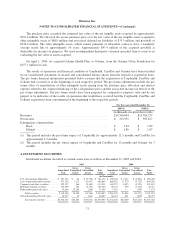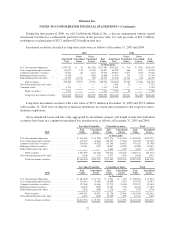Humana 2005 Annual Report Download - page 78
Download and view the complete annual report
Please find page 78 of the 2005 Humana annual report below. You can navigate through the pages in the report by either clicking on the pages listed below, or by using the keyword search tool below to find specific information within the annual report.Humana Inc.
NOTES TO CONSOLIDATED FINANCIAL STATEMENTS—(Continued)
Income Taxes
We recognize an asset or liability for the deferred tax consequences of temporary differences between the
tax bases of assets or liabilities and their reported amounts in the financial statements. These temporary
differences will result in taxable or deductible amounts in future years when the reported amounts of the assets or
liabilities are recovered or settled. We also recognize the future tax benefits such as net operating and capital loss
carryforwards as deferred tax assets. A valuation allowance is provided against these deferred tax assets if it is
more likely than not that some portion or all of the deferred tax assets will not be realized. Future years’ tax
expense may be increased or decreased by adjustments to the valuation allowance or to the estimated accrual for
income taxes.
We record reserves for contingent tax benefits when it is not probable that the tax return position taken with
respect to a particular transaction will be sustained. The contingency is not considered resolved until (1) the tax
audit statute of limitations has expired, (2) a settlement is reached with the appropriate level of taxing authorities,
or (3) the law changes such that there is objective evidence that it is probable that the uncertain tax position will
be sustained.
Professional Liability Risk
We bear general business risks associated with operating our Company such as professional and general
liability, employee workers’ compensation, and officer and director errors and omissions risks. Professional and
general liability risks may include, for example, medical malpractice claims and disputes with members
regarding benefit coverage. We retain these risks through our wholly-owned, consolidated insurance subsidiary.
We reduce exposure to our own general business risks by insuring levels of coverage for losses in excess of our
retained limits with a number of third party insurance companies. We remain liable in the event these insurance
companies are unable to pay their portion of the losses. In an effort to minimize credit risk, we insure our risks
with a number of insurance companies having a long history of strong financial ratings.
We accrue for professional liability claims reported and outstanding and an estimate of claims incurred but
not reported (based on actuarial determinations using past experience, modified for current trends) and
corresponding loss adjustment expenses incurred to adjudicate such claims. We continually review these
estimated liabilities, and make necessary adjustments. We believe our professional liabilities are adequate to
cover future payments required. However, given the nature and degree of uncertainty involved in projecting
professional liability losses and the potential size of a claim, the actual liability could differ significantly from the
amounts provided. We record the provision for professional liability losses, including any necessary adjustments
to the estimated liability as well as the cost of third party insurance coverage and related legal expenses, as an
administrative expense. We record estimated recoveries from third party insurers as a reduction of administrative
expense. The recoverable from third party insurers is included as an asset in the accompanying consolidated
balance sheet, as discussed in Note 10.
Derivative Financial Instruments
We use interest rate swap agreements to manage our exposure to interest rate risk. The differential between
fixed and variable rates to be paid or received is accrued and recognized over the life of the agreements as
adjustments to interest expense in the consolidated statements of income. Our interest rate swap agreements
convert the fixed interest rates on our senior notes to a variable rate and are accounted for as fair value hedges.
Our interest rate swap agreements are more fully described in Note 9.
68





